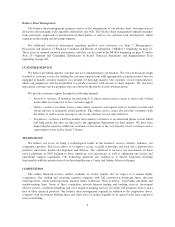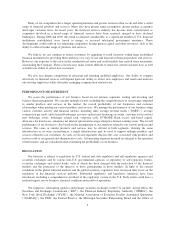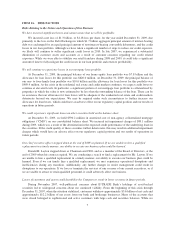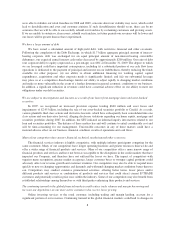eTrade 2009 Annual Report Download - page 17
Download and view the complete annual report
Please find page 17 of the 2009 eTrade annual report below. You can navigate through the pages in the report by either clicking on the pages listed below, or by using the keyword search tool below to find specific information within the annual report.• create liens;
• pay dividends or make other distributions;
• repurchase or redeem capital stock;
• make investments or other restricted payments;
• enter into transactions with our stockholders or affiliates;
• sell assets or shares of capital stock of our subsidiaries;
• receive dividend or other payments from our subsidiaries; and
• merge, consolidate or transfer substantially all of our assets.
As a result of the covenants and restrictions contained in the indentures, we are limited in how we conduct
our business and we may be unable to raise additional debt or equity financing to compete effectively or to take
advantage of new business opportunities. Each of these series of our corporate debt contains a limitation, subject
to important exceptions, on our ability to incur additional debt if our Consolidated Fixed Charge Coverage Ratio
(as defined in the relevant indentures) is less than or equal to 2.50 to 1.0. As of December 31, 2009, our
Consolidated Fixed Charge Coverage Ratio was (1.1) to 1.0. The terms of any future indebtedness could include
more restrictive covenants.
Although these covenants provide substantial flexibility, for example the ability to incur “refinancing
indebtedness” and to incur up to $300 million of secured debt under a credit facility, the covenants, among other
things, generally limit our ability to incur additional debt even if we were to substantially reduce our existing
debt through debt exchange transactions. We could be forced to repay immediately all our outstanding debt
securities at their full principal amount if we were to breach these covenants and did not cure the breach within
the cure periods (if any) specified in the respective indentures. Further, if we experience a change of control, as
defined in the indentures, we could be required to offer to purchase our debt securities at 101% of their principal
amount. Under our debt securities a “change of control” would occur if, among other things, a person became the
beneficial owner of more than 50% of the total voting power of our voting stock which, with respect to the 2011
Notes, 2013 Notes and 2015 Notes, would need to be coupled with a ratings downgrade before we would be
required to offer to purchase those securities.
We cannot assure that we will be able to remain in compliance with these covenants in the future and, if we
fail to do so, that we will be able to obtain waivers from the appropriate parties and/or amend the covenants.
The value of our common stock may be diluted if we need additional funds in the future or engage in
debt-for-equity exchanges in the future.
In the future, we may need to raise additional funds via debt and/or equity instruments, which may not be
available on favorable terms, if at all. If adequate funds are not available on acceptable terms, we may be unable
to fund our capital needs and our plans for the growth of our business. In addition, if funds are available, the
issuance of equity securities could significantly dilute the value of our shares of our common stock and cause the
market price of our common stock to fall. We have the ability to issue a significant number of shares of stock in
future transactions, which would substantially dilute existing stockholders, without seeking further stockholder
approval.
In addition, we may engage in future debt exchange transactions similar to the Debt Exchange we completed
in 2009, in which we issue new shares of common stock or securities convertible into or exchangeable or
exercisable for our common stock in exchange for our existing interest-bearing debt. Any such exchange
transactions would be designed to reduce the amount of interest we are required to pay in the future, reduce the
principal amount due at maturity and/or extend the maturity profile of our outstanding debt and may allow us to
recognize income to the extent we retire the debt at a fair value that is less than its face value, but would not in
any case result in our receiving cash proceeds. In any future debt exchange transactions, we expect that the fair
14
























